Optics | Physics - Refraction | 12th Physics : UNIT 6 : Ray Optics
Chapter: 12th Physics : UNIT 6 : Ray Optics
Refraction
REFRACTION
Refraction is passing through of
light from one optical medium to another optical medium through a boundary. In
refraction, the angle of incidence i in
one medium and the angle of reflection r in
the other medium are measured with respect to the normal drawn to the surface
at the point of incidence of light. Law of refraction is called Snell’s law.
Snell’s law states that,
a) The incident ray, refracted ray and normal to the refracting
surface are all coplanar (ie. lie in the same plane).
b) The ratio of angle of incident i in the first medium to the angle of reflection r in the second medium is equal to the
ratio of refractive index of the second medium n2 to that of the refractive index of the first medium n1.

The above equation is in the ratio
form. It can also be written in a much useful product form as,

The refraction at a boundary is
shown in Figure 6.15.
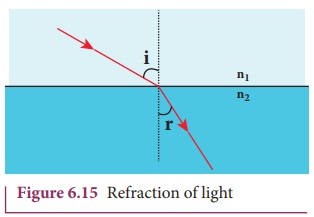
For normal incidence of light on a
surface, the angle of incidence is zero.
Angle of deviation due to refraction
We know that the angle between the
incident and deviated light is called angle of deviation. When light travels
from rarer to denser medium it deviates towards normal as shown in Figure 6.16.
The angle of deviation in this case is,

On the other hand, if light travels
from denser to rarer medium it deviates away from normal as shown in Figure
6.17. The angle of deviation in this case is,
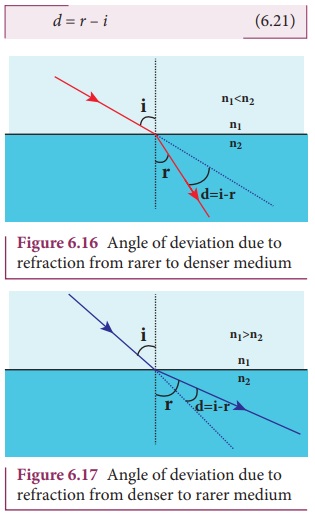
Characteristics of refraction
a) When light passes from rarer
medium to denser medium it deviates towards normal in the denser medium.
b) When light passes from denser
medium to rarer medium it deviates away from normal in the rarer medium.
c) In any
refracting surface there will also be some reflection taking place. Thus, the
intensity of refracted light will be lesser than the incident light. The phenomenon in which a part of light
from a source undergoing reflection and the other part of light from the same
source undergoing refraction at the same surface is called simultaneous reflection or simultaneous
refraction. This is shown in Figure 6.18. Such surfaces are available
as partially silvered glasses.
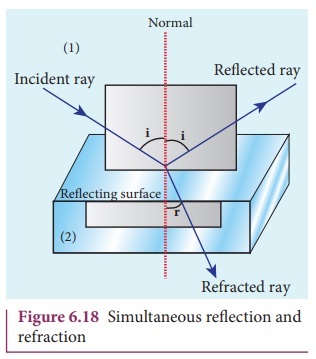
Production of optical surfaces
capable of refracting as well as reflecting is possible by properly coating the
surfaces with suitable materials. Thus, a glass can be made partially see
through and partially reflecting by varying the amount of coating on its
surface. It is commercially called as two way mirror, half-silverd or semi-silvered
mirror etc. This gives a perception of regular mirror if the other side is made
dark. But, still hidden cameras can be kept behind such mirrors. We need to be
cautious when we stand in front of mirrors kept in unknown places.
There is a method to test the two way mirror. Place the finger nail against the mirror surface. If there is a gap between nail and its image, then it is a regular mirror. If the fingernail directly touches its image, then it is a two way mirror.
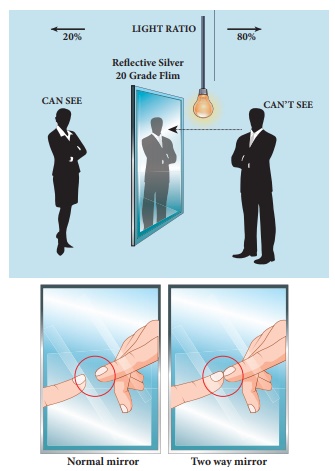
Principle of reversibility
The principle of
reversibility states that light will follow exactly the same path if its
direction of travel is reversed. This is true for
both reflection and refraction as shown in Figure 6.19.
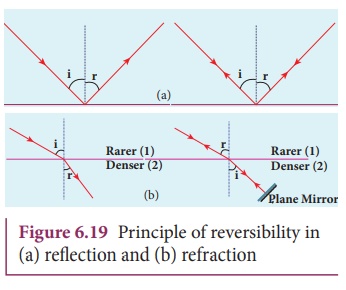
Relative refractive index
In the equation for Snell’s law, the term (n2/n1) is
callled relative refractive index of second medium with respect to the
first medium which is denoted as (n21).

The concept of relative refractive
index gives rise to other useful relation such as,
a) Inverse rule:

b) Chain rule:

EXAMPLE 6.7
Light travelling through transparent
oil enters in to glass of refractive index 1.5. If the refractive index of
glass with respect to the oil is 1.25, what is the refractive index of the oil?
Solution
Given, ngo =1.25 and ng =1.5
Refractive index of glass with
respect to oil,

Rewriting for refractive index of
oil,

The refractive index of oil is, no = 1.2
Apparent depth
It is a common observation
thatthebottom of a tank filled with water appears raised as shown in Figure
6.19(a). An equation could be derived for the apparent depth for viewing in the
near normal direction. The ray diagram is shown in Figure 6.19(b) and (c).

Light from the object O at the bottom of the tank passes from
denser medium (water) to rarer medium (air) to reach our eyes. It deviates away
from the normal in the rarer medium at the point of incidence B. The refractive index of the denser
medium is n1 and rarer
medium is n2. Here, n1 > n2. The angle of incidence in the denser medium is i and the angle of refraction in the
rarer medium is r. The lines NN ‘ and OD are parallel. Thus angle ∠DIB is also r. The angles i and r are very small as the diverging light
from O entering the eye is very
narrow. The Snell’s law in product form for this refraction is,

As the angles i and r are small, we can
approximate, sin i ≈ tan i;
n1 tani = n2 tan i
In triangles ∆DOB and ∆DIB,
tan(i) = DB/ DO
and tan(r) = DB/DI
n1 DB/DO = n2 DB/DI
DB is cancelled on both sides, DO is the actual depth d and DI is the apparent depth d'.
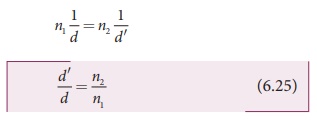
Rearranging the above equation for
the apparent depth d',

As the rarer medium is air and its refractive
index n2 can be taken as
1, (n2=1). And the
refractive index n1 of
denser medium could then be taken as n,
(n1=n).
In that case, the equation for
apparent depth becomes,

The bottom appears to be elevated by
d-d’.

EXAMPLE 6.8
A coin is at the bottom of a trough
containing three immiscible liquids of refractive indices 1.3, 1.4 and 1.5
poured one above the other of heights 30 cm, 16 cm, and 20 cm respectively.
What is the apparent depth at which the coin appears to be when seen from air
medium outside? In which medium the coin will be seen?
Solution
When seen from top, the coin will
still appear to be at the bottom with each medium appearing to have shrunk with
respect to the air medium outside. This situation is illustrated below.
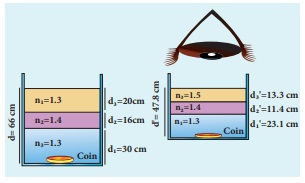
The equations for apparent depth for
each medium is,

Atmospheric refraction: Due to refraction
of light through different layers of atmosphere which vary in refractive index,
the path of light deviates continuously when it passes through atmosphere. For
example, the Sun is visible a little before the actual sunrise and also until a
little after the actual sunset due to refraction of light through the
atmosphere. By actual sunrise what we mean is the actual crossing of the sun at
the horizon. Figure shows the actual and apparent positions of the sun with
respect to the horizon. The figure is highly exaggerated to show the effect.
The apparent shift in the direction of the sun is around half a degree and the
corresponding time difference between actual and apparent positions is about 2
minutes. Sun appears flattened (oval shaped) during sun rise and sunset due to
the same phenomenon.
The same is also applicable for the
positions of stars as shown in Figure. The stars actually do not twinkle. They
appear twinkling because of the movement of the atmospheric layers with varying
refractive indices which is clearly seen in the night sky.
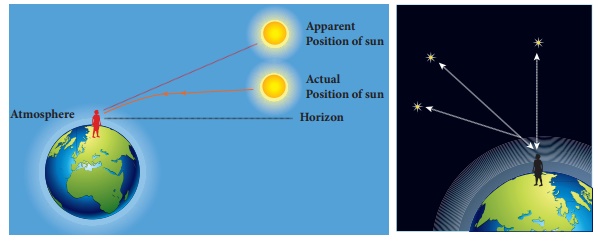
Critical angle and total internal reflection
When a ray passes from an optically
denser medium to an optically rarer medium, it bends away from normal. Because
of this, the angle of refraction r on
the rarer medium is greater than the corresponding angle of incidence i in the denser medium. As angle of
incidence i is gradually increased, r rapidly increases and at a certain
stage it becomes 90° or gracing the boundary. The angle of incidence in the denser medium for which the refracted ray
graces the boundary is called critical
angle ic.
If the angle of incidence in the
denser medium is increased beyond the critical angle, there is no refraction
possible in to the rarer medium. The
entire light is reflected back into the denser medium itself. This phenomenon
is called total internal reflection. These
are shown in Figure 6.21.
The two conditions for total
internal reflection are,
(a) light must travel from denser to
rarer medium,
(b) angle of incidence in the denser
medium must be greater than critical angle (i>ic).
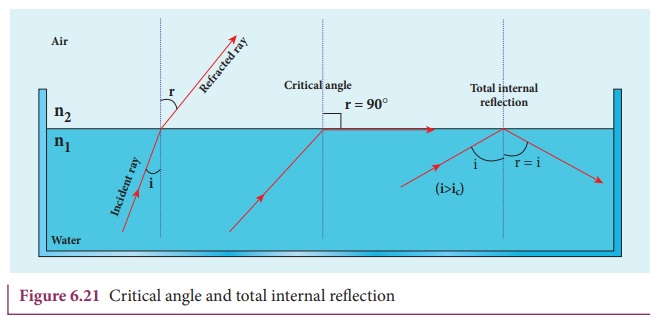
Snell’s law in the product form,
equation (6.19) for critical angle incidence becomes,

Here, n1 > n2
If the rarer medium is air, then its
refractive index is 1 and can be taken as n itself. i.e. (n2=1) and (n1=n).

For example the refractive index of
glass is about 1.5. The critical angle for glass-air interface is, ic = sin−1(1/1.5)
= 41.8º.
The critical angle for water-air
interface is, ic = sin−1(1/1.3)
= 48.6 º.
The critical angle ic depends on the refractive index of
the medium. Table 6.3 shows the refractive index and the critical angle for
different materials.

Related Topics